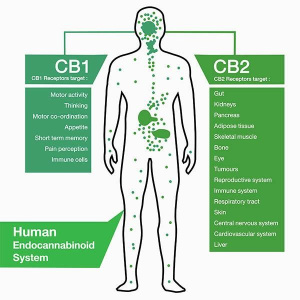Endocannabinoids and the endocannabinoid system are a fairly recent area of study in the science world. When one just looks at the word “endocannabinoid,” probably one of the first things that comes to mind is “weed” or cannabis. This thought is valid and partially correct as the cannabinoids found in cannabis are incredibly similar to the ones naturally produced by our bodies, the endocannabinoids. Endocannabinoids are neurotransmitters that are released in the body as necessary, and they assist with multiple bodily functions. The two main endocannabinoids are arachidonyl ethanolamide (AEA) and 2-arachidonoylglycerol (2-AG). Hydrolases and lipases break these endocannabinoids down after carrying out a response.

The Endocannabinoid System (ECS)
The ECS is a biological system that contributes to the regulation of various bodily functions:
- Metabolism
- Sleep
- Pain
- Immune responses
- Homeostasis
These responses are triggered when an endocannabinoid binds to cannabinoid receptors on the surface of cells. Depending on the type of receptor and where in the body the endocannabinoid is binding to such a receptor, a variety of responses can be carried out. The two primary receptors are CB1 and CB2 receptors which are G-protein coupled receptors with endocannabinoids as their agonists.

CB1: Present in the central nervous system (brain and spinal cord). Binding to CB1 can result in pain relief.
CB2: Present in the peripheral nervous system and immune system. Binding to CB2 can result in anti-inflammatory responses.
ECS and Neurodegenerative Disease
Recent studies have found potential therapeutic targets of the ECS in neurodegenerative diseases such as Huntington’s disease, Alzheimer’s disease, and Multiple Sclerosis. No, this does not involve smoking marijuana as a treatment for these diseases. In general for these diseases, it was found that increased expression of CB1 and CB2 creates neuroprotective effects and increases synaptic plasticity. In the case of Alzheimer’s, activation of these receptors even prevented amyloid beta plaque buildup, characteristic of the onset of Alzheimer’s disease! Although these findings are quite promising, there are still many challenges to concur before these treatments are put into practice. Due to the widespread expression of endocannabinoids and their variable role in excitatory and inhibitory processes, there is still much to learn about this vast system.
ECS and Drug Abuse
The ECS plays a key role in our bodies reward pathways, both natural and drug-related. Endocannabinoids and cannabinoid receptors are highly expressed in the mesocorticolimbic system which houses most of the body’s dopamine pathways. With drug addiction, endocannabinoids and their receptors participate in compulsion, maintenance of drug consumption, and the loss of control seen with addicted individuals. The ECS is modified by drug consumption and even further modified with addiction, contributing to such addiction.
On a brighter note, research is currently being done to target the ECS to treat addiction. A negative allosteric modulator for the CB1 receptor and inhibitor of the CB2 receptor are being studied as a hopeful treatment of the overactive ECS we see in addicted individuals! There are even studies that show the use of CBD or marijuana as a potential treatment for drug addiction as it has a power to reduce cravings and increase the feeling of reward without the drug of addiction. Basically, using other drugs to treat drug addiction! Makes sense, right? That is the beauty of the endocannabinoid system!
References
De Pietro, M. (2021). “What to know about endocannabinoids and the endocannabinoid system.” Medical News Today. https://www.medicalnewstoday.com/articles/endocannabinoid#production.
Kendall, D. A., & Yudowski, G. A. (2017). Cannabinoid receptors in the central nervous system: their signaling and roles in disease. Frontiers in Cellular Neuroscience, 10. https://doi.org/10.3389/fncel.2016.00294
Manzanares, J. et al. Role of the endocannabinoid system in drug addiction. Biochem Pharmacol 2018, 157:108-121. https://pubmed.ncbi.nlm.nih.gov/30217570/.
Navarrete, F.; García-Gutiérrez, M.S.; Gasparyan, A.; Navarro, D.; López-Picón, F.; Morcuende, Á.; Femenía, T.; Manzanares, J. Biomarkers of the Endocannabinoid System in Substance Use Disorders. Biomolecules 2022, 12, 396. https://www.mdpi.com/2218-273X/12/3/396.
